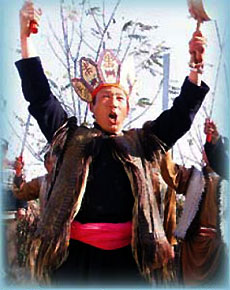Various crops are also planted in accordance with different ethnic groups, including paddy rice for the Dong people, highland barley for the Tibetans and buckwheat for the Yi.
"We hope to encourage visitors to enter the lives of different ethnic groups," says Wang.
|

The Qiang people enjoy a worshiping ceremony for a prosperous new year. [China Daily]
|
Some buildings in the park are original, taken apart at their original spots and then transported to, and reassembled in, Beijing. Others were prepared in the original place and assembled in Beijing.
For example, the symbol of the village of the Salar, a Muslim ethnic group in Northwestern China, is a minaret from the Shangbaizhuang village, Baizhuang township, Xunhua Salar autonomous county, Qinghai province.
The minaret was built around 300 years ago, and was moved to the Chinese Ethnic Culture Park in 2003.
In the southern part of the Chinese Ethnic Culture Park, one can visit a replica of the Ermin Tower, an ancient tower in Turpan, Xinjiang Uygur autonomous region.
Standing a towering 44 m, it is exactly the same size as the original. The grey-yellow bricks were all made manually in Xinjiang and assembled in Beijing by Uygur craftsmen from Xinjiang.
In the northernmost part of the park, a drum tower, opera stage and "rain and wind bridge" represent the surroundings of a village of the Dong people. A field of paddy rice and ducks and fish in the lake further add to the idyllic atmosphere of the environment.
The park also features live cultural performances. Every morning real lamas from the Tar Monastery of Qinghai province chant Tibetan Buddhist sutras to pray for peace at the Tibetan monastery, while a dongba priest burns incense and says his prayers at the Naxi village.
Then performers of the Miao minority put on a show of "walking on blades", a traditional Miao stunt, while singers and dancers of other ethnic groups such as the Va, Jingpo and Tu entertain visitors with their program in each village.
Throughout the year, festivals of various ethnic groups are celebrated, including the Tibetan Shotan Festival, the Water-sprinkling Festival of the Dai people and the Torches Festival of the Yi.
"Most minority people are very good at singing and dancing. Participating in their activities helps us understand and respect their cultures more," says Lei Feng, a 47-year-old visitor to the park.
Liu Li, a 29-year-old visitor, took part in the "bamboo-pole dance" of the Dai people and found in it a long-lost joy like that of the "skipping elastic band" game in her childhood.